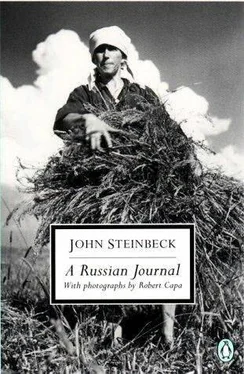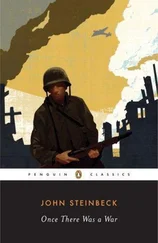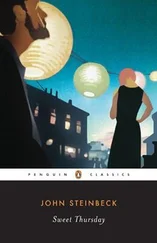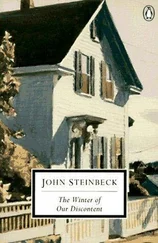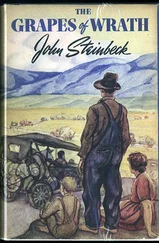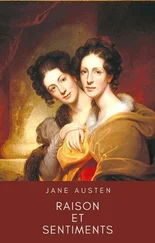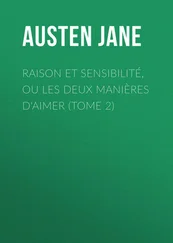John Steinbeck - A Russian Journal
Здесь есть возможность читать онлайн «John Steinbeck - A Russian Journal» весь текст электронной книги совершенно бесплатно (целиком полную версию без сокращений). В некоторых случаях можно слушать аудио, скачать через торрент в формате fb2 и присутствует краткое содержание. Жанр: Классическая проза, на английском языке. Описание произведения, (предисловие) а так же отзывы посетителей доступны на портале библиотеки ЛибКат.
- Название:A Russian Journal
- Автор:
- Жанр:
- Год:неизвестен
- ISBN:нет данных
- Рейтинг книги:4 / 5. Голосов: 1
-
Избранное:Добавить в избранное
- Отзывы:
-
Ваша оценка:
- 80
- 1
- 2
- 3
- 4
- 5
A Russian Journal: краткое содержание, описание и аннотация
Предлагаем к чтению аннотацию, описание, краткое содержание или предисловие (зависит от того, что написал сам автор книги «A Russian Journal»). Если вы не нашли необходимую информацию о книге — напишите в комментариях, мы постараемся отыскать её.
A Russian Journal — читать онлайн бесплатно полную книгу (весь текст) целиком
Ниже представлен текст книги, разбитый по страницам. Система сохранения места последней прочитанной страницы, позволяет с удобством читать онлайн бесплатно книгу «A Russian Journal», без необходимости каждый раз заново искать на чём Вы остановились. Поставьте закладку, и сможете в любой момент перейти на страницу, на которой закончили чтение.
Интервал:
Закладка:
As a travel narrative, collaborative project, and structural experiment, Sea of Cortez is paradigmatic of Steinbeck's work throughout the restless 1940s, culminating with A Russian Journal at the end of the decade. "He tried to enter the great world, so to speak," remarked Arthur Miller. His search for inspiration sparked a kind of frenetic decade of experimentation; he wrote film scripts, journalism, travel diaries, plays, novellas. Indeed, travel became a kind of panacea for Steinbeck during the 1940s. Claiming that "there's an il-logic there I need," he went to Mexico several times throughout the decade. In 1941, at the urging of documentary filmmaker Herbert Kline, he wrote a script about health problems in a remote Mexican village, The Forgotten Village. After the war, he repeatedly returned to write and then film The Pearl, and in 1-948 he went again to Mexico to work on a film treatment of Emiliano Zapata's life for Elia Kazan's great film Viva Zapata!
Steinbeck's contributions to the United States' involvement in World War II also shattered his self-containment of the 1930s and carried him far from his native California-first to Washington, D.C., in 1941, where he was interviewed by a newly formed information and propaganda agency, the Foreign Information Service; then to New York City, where he settled with Gwyn Conger, the woman who would become his second wife. There he wrote his first contribution to the war effort, The Moon Is Down (1942), a play-novelette about an occupied Scandinavian country that won wide approval in Europe among underground groups resisting Nazi oppression. In America, Steinbeck's novel-and the play and film of the work that followed in quick succession-received a less enthusiastic response, for the country was not prepared to see invaders, clearly Germans, as human. Disappointed, Steinbeck went on to other war-related projects: he wrote radio scripts for the FSI early in 1942; later, he was asked to write a text about training air force bombing crews, an assignment that called for Steinbeck and photographer John Swope to visit training sites around the United States.
Once again settled on the East Coast, he worked doggedly on the text of Bombs Away, The Story of a Bomber Team (1942), writing to his college friend Webster Street: "I get farther and farther away from the old realities and more and more immersed in this dreamlike war. When it is over I'm not going to be able to remember what it was like." Other war-related projects followed: with childhood friend Jack Wagner, Steinbeck wrote a "sample script" for a film, A Medal for Benny, about a small town's reception of their war hero, a ne'er-do-well from the wrong side of town. Early in 1943 he wrote a novella for Hitchcock's famous movie about survivors from a torpedoed freighter cast adrift at sea, Lifeboat. Finally, in mid-1943, he was given the assignment that used his talents most successfully: that summer, he was sent overseas by the New York Herald Tribune as a war correspondent to England, West Africa, and ultimately to cover a diversionary mission off the coast of Italy.
In many ways A Russian Journal is the final chapter of this war journalism. When in Stalingrad, "an expanse of ruin," Steinbeck writes that "Our windows looked out on acres of rubble, broken brick and concrete and pulverized plaster, and in the wreckage the strange dark weeds that always seem to grow in destroyed places." In that terrain, "there was a little hummock, like the entrance to a gopher hole. And every morning, early, out of this hole a young girl crawled." In this one vignette about a hounded, dazed child, Steinbeck captures the agony of besieged Stalingrad. Framed by a window, the verbal composition is crafted to accompany Capa's photos. Indeed, one of the most remarkable qualities of A Russian Journal is the way that
Steinbeck's reporting and Capa's photojournalism intersect. Steinbeck's method seems purely photographic, as if the project itself-collaboration with a photographer-dictated style and approach. As he insistently notes in the first chapter of A Russian Journal, the writer and photographer intend to record only what is seen, nothing more. The photograph is an apt metaphor for visiting the Soviet Union in 1947, where visitors were shown so very little of Stalin's domain, always circumscribed.
II
"John was actually a missionary. He was essentially a journalist… I think he could see things going on… I mean journalist in the power of observation."-Toby Street
The role of literary journalist was not, in 1943, a new one for John Steinbeck. His missionary zeal had found an outlet in the late 1930s, when the heretofore apolitical writer turned his gaze to the contemporary scene in California. The urgent realism of In Dubious Battle and Of Mice and Men has a journalistic thrust. The impetus behind The Grapes of Wrath was more essentially documentary. In August 1936, Steinbeck was sent by the San Francisco News, a decidedly liberal newspaper, to write a series on migrants in California; those seven articles, published as "The Harvest Gypsies," were Steinbeck's first journalistic triumph, a foray into literary witness that conveyed, through the author's fidelity to truth, the emotional context of the migrants' sorrow. With searing prose, he etched the plight of migrant families: "… in the faces of the husband and his wife, you begin to see an expression you will notice on every face; not worry, but absolute terror of the starvation that crowds in against the borders of the camp." He described migrants clinging to respectability: "The house is about 10 feet by 10 feet, and it is built completely of corrugated paper… With the first rain the carefully built house will slop down into a brown, pulpy mush…" Witness to social upheaval, Steinbeck's eye reported the conditions endured and the dignity maintained by people on the edge.
Seven years later, sent to cover World War II, he brought the same compassion and sharp eye for detail to the neglected aspects of the war-helmeted men on a troop ship looking "like long rows of mushrooms"; bomber crews dressing for combat, getting "bigger and bigger as layer on layer of equipment is put on. They walk stiffly, like artificial men"; the people of Dover who are "incorrigibly, incorruptibly unimpressed" with German might and muscle. And in one of the most emblematic pieces, Steinbeck writes about London under seige:
People who try to tell you what the blitz was like in London start with fire and explosion and then almost invariably end up with some very tiny detail which crept in and set and became the symbol of the whole thing for them… "It's the glass," says one man, "the sound in the morning of the broken glass being swept up, the vicious, flat tinkle."… An old woman was selling little miserable sprays of sweet lavender. The city was rocking under the bombs and the light of burning buildings made it like day… And in one little hole in the roar her voice got in-a squeaky voice. "Lavender!" she said. "Buy Lavender for luck."
The bombing itself grows vague and dreamlike. The little pictures remain as sharp as they were when they were new.
Here, as in his best journalism, Steinbeck excelled at the little picture in the midst of cataclysmic events: in A Russian Journal, it is the girl in the Stalingrad rubble; or the bookkeeper proudly showing his scrapbook saved from war's destruction; or the photos of the lost soldiers on walls of little Ukrainian houses. Even in fiction, the Joads' misery is best captured in vignettes: Ma's colloquies with Rose of Sharon, the rollicking dance at the government camp, Uncle John's sending the dead baby down the river, images easily translated into film. Steinbeck's great strength as a writer was rarely the sustained narrative thrust. Few of his novels are highly plotted. In his best work Steinbeck's vision is scenic, highly influenced in the 1930s by documentary film, in the 1940s by a commitment to accuracy and the atypical yet also starkly ordinary angle. In addition, Steinbeck brought to war reporting, noted the famed war correspondent Ernie Pyle, whom Steinbeck met in North Africa, a delicate sympathy for mortal man's transient nobility and beastliness that I believe no other writer possesses. Surely we have no other writer so likely to catch on paper the inner things that most people don't know about war-the pitiableness of bravery, the vulgarity, the grotesquely warped values, the childlike tenderness in all of us.
Читать дальшеИнтервал:
Закладка:
Похожие книги на «A Russian Journal»
Представляем Вашему вниманию похожие книги на «A Russian Journal» списком для выбора. Мы отобрали схожую по названию и смыслу литературу в надежде предоставить читателям больше вариантов отыскать новые, интересные, ещё непрочитанные произведения.
Обсуждение, отзывы о книге «A Russian Journal» и просто собственные мнения читателей. Оставьте ваши комментарии, напишите, что Вы думаете о произведении, его смысле или главных героях. Укажите что конкретно понравилось, а что нет, и почему Вы так считаете.
